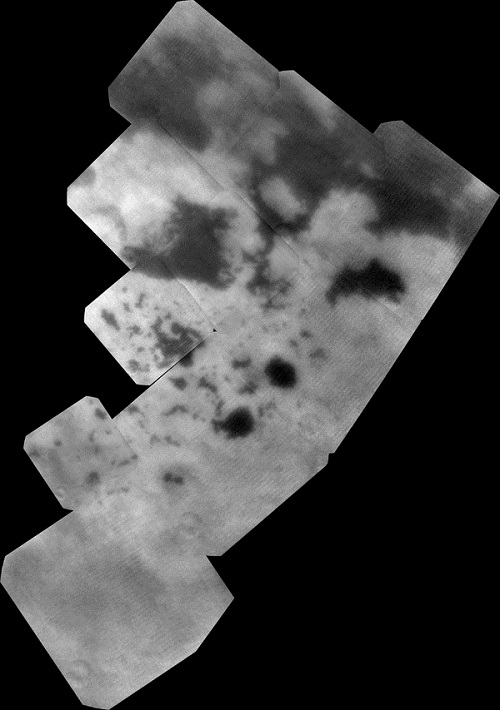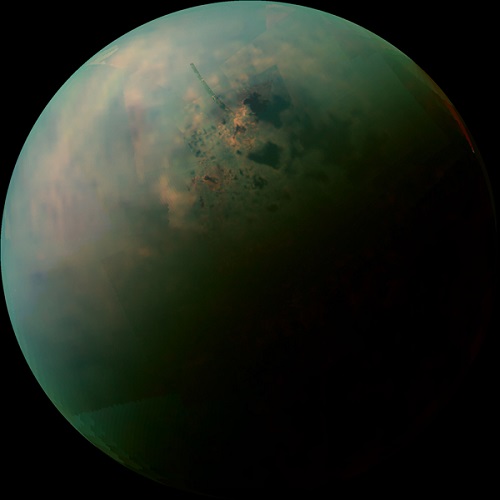New views from Cassini are giving us a much better look at Titan’s north pole and the seas and lakes that make the region so distinctive. This is particularly interesting because most of the moon’s lakes are concentrated at its northern latitudes, a fact that demands an explanation. The new near-infrared images show an area of bright terrain in this northern region that had not been observed before. This news release from the Jet Propulsion Laboratory suggests that the surface thus revealed is unique on Titan. If we can figure out what’s going on here, we may have an explanation for the concentration of lakes and seas in these latitudes.

Image: The vast hydrocarbon seas and lakes (dark shapes) near the north pole of Saturn’s moon Titan sprawl out beneath the watchful eye of NASA’s Cassini spacecraft. Scientists are studying images like these for clues about how Titan’s hydrocarbon lakes formed. Titan is the only world other than Earth that is known to have stable bodies of liquid on its surface. Credit: NASA/JPL-Caltech/SSI/JHUAPL/Univ. of Arizona.
One explanation for the bright areas surrounding the lakes is so-called karst terrain, in which liquids have dissolved soluble bedrock — the Carlsbad Caverns in New Mexico are an example of such terrains on Earth. Another possibility: Land that has collapsed after a volcanic eruption, which could explain the distinctive round silhouettes and steep sides of these lakes. For an idea of scale, the largest of the seas, at upper right, is Kraken Mare, which is about the size of the Caspian Sea and Lake Superior put together. Kraken Mare is Titan’s largest sea; Ligeia Mare, the second largest sea, is to its left, a body about 500 kilometers across.
A number of factors make the new imagery possible. The viewing geometry of two recent Titan flybys has been an improvement over previous encounters. We’ve studied much of this terrain with radar, but the partial or oblique views we’ve recorded through Cassini’s visual and infrared mapping spectrometer and imaging science subsystem can now be supplemented with these more detailed images. Moreover, the haze that coated the north pole has broken up with the approach of summer in the area, with cloudless, sunny weather now becoming the norm.
“The view from Cassini’s visual and infrared mapping spectrometer gives us a holistic view of an area that we’d only seen in bits and pieces before and at a lower resolution,” said Jason Barnes, a participating scientist for the instrument at the University of Idaho, Moscow. “It turns out that Titan’s north pole is even more interesting than we thought, with a complex interplay of liquids in lakes and seas and deposits left from the evaporation of past lakes and seas.”
Indeed, we seem to be looking at something like the salt flats found on Earth, only here the evaporated material is likely to be organic compounds originally from particles in Titan’s haze that had once been dissolved in liquid methane. In the image below, these materials appear orange against the green background of water ice. Remember that images like these are colorized mosaics based on mapping infrared colors into the spectrum of visible colors, allowing us to see the variation in the lakes and their surrounding materials.

Image: This false-color mosaic, made from infrared data collected by NASA’s Cassini spacecraft, reveals the differences in the composition of surface materials around hydrocarbon lakes at Titan, Saturn’s largest moon. The orange areas are thought to be evaporite — the Titan equivalent of salt flats on Earth. The evaporated material is thought to be organic chemicals originally from Titan’s haze particles that once dissolved in liquid methane. They appear orange in this image against the greenish backdrop of Titan’s typical bedrock of water ice. Credit: NASA/JPL-Caltech/University of Arizona/University of Idaho.
“Titan’s northern lakes region is one of the most Earth-like and intriguing in the solar system,” said Linda Spilker, Cassini project scientist, based at NASA’s Jet Propulsion Laboratory, Pasadena, Calif. “We know lakes here change with the seasons, and Cassini’s long mission at Saturn gives us the opportunity to watch the seasons change at Titan, too. Now that the sun is shining in the north and we have these wonderful views, we can begin to compare the different data sets and tease out what Titan’s lakes are doing near the north pole.”
Indeed, and every new revelation from Cassini reminds us of what we might achieve with a new probe to Titan. The ideas are out there even if the funding is not, but the day may come when we see an airborne vehicle like AVIATR, designed to stay aloft for a one-year mission in Titan’s thick atmosphere, eventually reach the distant moon. And the work that has gone into concepts like Titan Mare Explorer and related studies on the Planetary Lake Lander remind us how useful it would be to be able to put an instrument platform into one of these intriguing ethane seas.



To me, they look like sinkholes (i.e., the karst explanation). Compare with this aerial photo of Lake Placid, Florida – all of the lakes are sinkholes.
http://www.landsat.com/lake-placid-florida-aerial-a1238625.html
About Titan explorer concepts, here is a nice one :
http://www.astrobio.net/exclusive/5762/a-super-ball-bot-for-titan-a-baby-step-to-learning-about-saturn’s-unique-moon
It is not surprising to me that Titan has a dominant Nitrogen Atmosphere.
But to have a rather large amount of surface organic compounds as part of its inital formation seems odd to me.
Is there a theory as to where the carbon compounds came from?
protoplanetary nebula?, or is a feature of such a thick atmosphere capturing
many dirty comets and chrodrite which disintegrate on the way in rather than
punching into the icy mantle.
Looking at the Satellites of Jupiter, I know that solar winds would have stripped much of those satellites primordial atmosphere. But If they had started with Organic compounds too, why isn’ t there any evidence of it on
their surfaces, ethane & acetyline arent exactly as light as N2, Or would
they also drift off.
Except for Io, all of the others Galiean moons seem mostly Iceballs all around.
And speaking of asteroidal impacts, what happens to an ice mantle when
struck by one. Does the heat and melt cyle leave no trace of a crater or is the crater a different shape/color.
I am going to put out an idea, do not even know if it possible:
The atmosphere of Titian is denser then earth’s, but gravitational force is less so the atmospheric gradation is different. As Cassini nears it’s useful life span’s end would it not be possible to arrange for the probe to glaze the upper atmosphere of Titian during several flybys thereby reducing it’s speed. We have successful used atmospheric breaking before and as the speed of Cassini is reduced during these flybys it could be then be placed in orbit around Titan. I do not know if the orbital mechanics would allow this, or if the probe would have enough fuel left to make any orbital adjustments. Just a thought experiment which may or may not be possible. Is we could do this with Cassini it would give us an orbital probe around Titan decades before it might otherwise thought to be possible…………….Tom
I wonder how long Titan has had an atmosphere, I mean the Sun was a lot cooler eons ago. A billion years ago Titan could have been a lot like Triton with a nitrogen rich crust . It is possibly this reason why there is still a lot of methane in the atmosphere/ground as it is still degasing.
“A billion years ago Titan could have been a lot like Triton with a nitrogen rich crust ”
What! Early in the Sun’s history it was up to 30% dimmer than today, and since temperature is the fourth power of radiation flux, equilibrium temperature would be 8.5% lower at the simplest BOTE calculation. That would push Titan down form its current temperature of 94K where it is too hot for lakes to form anywhere at the poles, to a friendlier 86K, where the tropics are no longer dry uninteresting deserts. Triton is currently less than half either temperature at 38K.
Rob Flores asks a crucial question with”Is there a theory as to where the carbon compounds came from?”
Not long ago everyone would have assumed that most of those organics that coat the immediate surface were ‘tholins’ formed by the action of uv light on a methane-nitrogen atmosphere. These should contain much nitrogen, and the process should produce particularly high loads of acetylene. They seem to differ from advertised, so all bets are off. It feels wonderful to speculate that much of it has been eaten leaving nitrogen poor tars we see, but is that likely either??